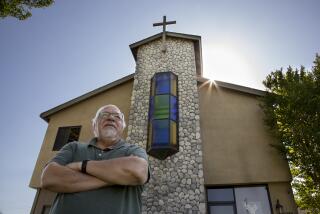Health Care Costs Create Epidemic of Concern in Many Denominations
- Share via
While thanking this summer’s General Assembly of the Presbyterian Church (U.S.A.) for a “wonderful year,” outgoing Moderator Kenneth Hall also ended on a worried note--one of enormous practical importance for many small and average-size churches.
“Health care costs have become a burden on our churches,” Hall said, then warned that congregations with fewer than 200 members may no longer be able to afford (the salary and benefits of) a full-time pastor.
Hall could have been speaking for most of America’s mainline denominations.
Virtually all of the major churches have been hit hard by ballooning costs and view the medical coverage situation as critical.
Denominations are groping for ways to contain insurance costs while still maintaining benefits. But with national health care expenditures rising about 9% annually for much of the past decade, it is an uphill battle.
Currently, most churches employ one of two basic methods for providing coverage. Some use commercial insurance companies for ministers and other workers. Others use denomination-based health plans.
There are, however, an array of variations available. For instance, some denominations provide national plans that are mandatory for all clergy. In other churches, participation in medical plans is optional. Still others provide coverage by region or district and, in some cases, individual ministers are responsible for providing their own coverage based on a congregation’s ability to pay.
No matter what form is used or how well the funds are managed, the churches have no control over the never-ending increases in medical costs that are causing nightmares for providers of health care coverage in every segment of society.
But the one big disadvantage for the churches, as one church executive points out, is that denominations, unlike businesses, cannot increase the price of their product to meet the rising costs.
The churches have taken some action aimed at bringing costs under control by increasing premiums and deductibles (the amount the insured must pay before the insurance plan takes effect) and by cutting back on coverage. But those measures represent only the first steps up the mountain of costs.
Among the hardest hit by the crisis are some ministers of smaller congregations who have begun to divert funds from their pension plans in order to pay for limited medical coverage. And denominations fear that others may be left unprotected, forced to drop medical insurance altogether because their congregations cannot generate enough income to pay for it.
Few churches have gone unaffected by problems of escalating medical costs, as a survey of denominations illustrates.
PRESBYTERIAN CHURCH (U.S.A.) In hope of gaining some control over steadily rising costs that contributed to a major medical fund net loss of $18 million during 1988, the church has been casting about to find a company that will take on the church’s troubled self-insured medical plan.
However, as of mid-July, none of the 12 insurance companies contacted would touch the plan, which hit local congregations with a 3% increase on the pastor’s salary and housing in 1988 and a 2% increase this year.
Claudia B. Smith, vice president of benefits for the church’s Board of Pensions, said experts in the field are not optimistic that the church will be able to find an insurance company willing to operate a churchwide program that gives members any better deal than they now have.
Indeed, to Smith the future looks grim: “There will continue to be increases and/or benefit reductions as long as the rate of inflation continues to go up each year. That’s just simple mathematics.”
In addition to the premium rate increases in the last two years, the Presbyterian plan, effective last Jan. 1, increased the deductible charged to members on the family plan from 2% of salary to 3%.
“Our experience . . . is practically identical to what is happening in the American economy in general,” said Smith. “We are facing the same tough decision as every other entity out there.”
But there is one critical difference between the way rising medical costs affect churches and the businesses that produce a product, she noted, explaining, “We can’t add on to the cost of another widget.”
UNITED CHURCH OF CHRIST
At its General Synod earlier this summer, the United Church of Christ approved a resolution noting that premium rates for the church’s self-insured medical plan escalated by 40% in 1988 and “are quickly moving beyond small churches’ and retired clergy’s financial ability to participate, and may leave many persons uninsured and at risk.”
The resolution encourages all UCC churches and national bodies to participate in the church’s voluntary plan as a strategy for reducing premiums.
Joan F. Brannick, administrative vice president of the United Church of Christ Pension Boards, said UCC policy requires churches to provide medical benefits to clergy, either through the church’s plan or other options.
While she said she knows of no situation where ministers are going without benefits, Brannick would not rule out that possibility, saying, “My guess is that there are as many variations as you can imagine because there are very small churches feeling the pinch.”
Not only have premium rates for the church-sponsored medical plan escalated by 40% in the past year, but deductible amounts have been increased as well.
UNITED METHODIST CHURCH
The United Methodist Church’s Board of Pensions last week authorized a task force to examine the feasibility of establishing a church-wide medical benefits program.
Currently, each United Methodist “annual conference,” or regional body, oversees its own medical program. But cost increases averaging about 20% annually in the last several years and the disparity in benefits provided from conference to conference have created “an incredible amount of discussion” within the denomination, prompting establishment of the task force, according to the Rev. Tom Marston, director of the board’s Benefits Department.
Marston said the church finds itself in “a very fluctuating situation,” as some conferences consider dropping plans provided by insurance companies in favor of their own self-insured plans, while other conferences proceed in the reverse direction.
“I think they’re trying to take the best-educated guess,” said Marston.
EVANGELICAL LUTHERAN CHURCH IN AMERICA
The Evangelical Lutheran Church in America, formed in 1988 from a merger of three predecessors, paid $38 million in medical claims out of its medical plan in 1988, and without changes in the church’s plan those costs are expected to increase to $45 million this year and to $53 million in 1990.
At its Churchwide Assembly to be held in August, the church is scheduled to consider recommendations by its Board of Pensions calling for optional coverage for spouses and dependents and an increase in member costs from the current 10% to 20% of eligible expenses.
Kathryn A. Barrus, vice president for medical/dental administration for the Board of Pensions, said, “It is unfortunate that the ELCA started out at a time when medical costs were increasing tremendously.”
During the young denomination’s first year, she reported, rising costs forced the church to increase medical premium charges from 8.1% to 9.9% of employee compensation.
According to Barrus, contribution rates are likely to increase from 9.9% of employee compensation to 13.5% if the Board of Pensions recommendations are not approved by the Churchwide Assembly.
SOUTHERN BAPTIST CONVENTION
John Dudley, senior vice president of insurance services for the Southern Baptist Convention, which is enrolled in an Aetna Life and Casualty plan, said, “I would say it’s approaching the critical point. . . . We’re greatly concerned about our churches continuing to be able to afford these rate increases.”
Under SBC policy, medical coverage is not required for clergy or lay workers. While 37,000 Southern Baptist churches, or roughly half the denomination total, participate in the Aetna plan, Dudley said he believes many of the smaller churches simply do not provide medical coverage.
“The salaries of the pastors and the congregations just don’t allow for that,” Dudley said.
In some instances, he said, employees are diverting contributions away from their pension plans in order to maintain health benefits. “I suspect we’re going to see greater numbers dropping by the wayside if this thing continues,” Dudley predicted.
ROMAN CATHOLIC CHURCH
Sister Christine Matthews, executive director of the Roman Catholic National Assn. of Church Personnel Administrators, noted that each Catholic diocese in the country decides its own medical coverage policy.
While Sister Matthews said she had not noticed any patterns in the ways dioceses are responding to increasing medical costs, she did say one thing is clear--the situation is critical.
Among some of the options being explored are statewide plans that would include more than one diocese, “cafeteria” plans that give employees more choices on the kinds of coverage they can purchase, and raising deductibles.
“Dioceses are looking for ways to use the money wisely and still keep the best benefits for employees.” Commenting on the general health care cost crisis, she said, “I think something has to be done in this country to help cope.”
More to Read
Sign up for Essential California
The most important California stories and recommendations in your inbox every morning.
You may occasionally receive promotional content from the Los Angeles Times.













